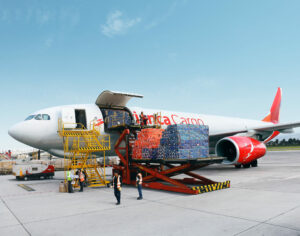Feb 19, 2024

Handling flowers in the air cargo industry has challenges that require innovative solutions. Maintaining optimal temperature control is key, as flowers are very sensitive to temperature fluctuations. The fragility of flowers requires careful conditioning to avoid physical damage during carriage. Time-sensitive flower transport requires effective logistical coordination to ensure on-time delivery, while compliance with customs and phytosanitary regulations adds a layer of complexity.
“At Avianca Cargo, we have been working for and with the flower industry in Colombia and Ecuador for more than 50 years, hand in hand with Asocolflores and Expoflores, the respective associations of these countries,” Diogo Elias, Senior Vice President at Avianca Cargo, said.
“The COVID-19 pandemic posed several challenges for the flower and perishables segments. How these sectors have rebounded in the post-pandemic era is noteworthy. Initially, the pandemic led to an unexpected surge in demand, causing prices go to the roof.
“However, this heightened demand has gradually tapered off, returning to levels like those pre-COVID. It remains uncertain whether we will see an imbalance in supply and demand, both in the flower market and in transportation.”
READ: Busy cargo season begins at Quito airport
Seasonal success
With close to 18,000 tonnes transported from Colombia and Ecuador to the United States for Valentine’s Day this year, Avianca Cargo doubled its regular capacity for this product, operating around 300 flights during the season, providing its customers with the highest levels of quality, service and punctuality.
The company prepares months in advance for Valentine’s Day, and this year it’s focus was on implementing logistical solutions to ensure an efficient season. Avianca Cargo invested in infrastructure in Miami, the flower’s main destination, expanding and modernising the Jetfloor (the type of floor used), offering a new configuration in the cooler, thus increasing its capacity by 83% to serve up to six flights simultaneously.
Also in Miami, the company set a new record in flower processing and delivery times to its customers, reducing them by 57%, and increased its perishable cargo depalletisation (pallet breakdown) capacity by 40%. In Bogota, Avianca Cargo implemented extended receiving hours for 24/7 service on the receiving lines; increased personnel in the operation by 30%; and implemented a system with virtual scheduling that reduced cargo acceptance times by 56% compared to 2023.
“This Valentine’s Day season once again positions us as the leading cargo airline transporting flowers from Colombia to North America, doubling our capacity and strengthening the flower industry in the region. With the immense responsibility of fulfilling the customer’s promise, we executed a great season with service levels above 90%. This is an enormous effort by the Avianca Cargo team, inspired by the trust of our customers and with precise coordination with all the actors in the supply chain. Avianca Cargo has been there from the beginning and will continue to take our region’s flowers around the world for many years to come,”
Among the most exported flowers this season by the airline were roses and carnations from Bogota; pompons, hydrangeas and chrysanthemums from Medellin; and roses, carnations and gypsophila from Quito.
READ: Avianca Cargo leads flower transportation from Colombia to North America
Packaging petals
The breakdown between air, road, and sea as the main methods of transportation for flowers varies. Air transportation continues to account for over 90%, while sea transportation represents around 10%. In remote regions such as Asia, air transportation reaches 100%.
Selecting and qualifying the right packaging for flowers during its journey is crucial, especially considering the significant number of boxes of flowers being shipped. Given the considerable volumes involved, it is essential to ensure that each box is properly packed and identified, depending on the type of packaging and its characteristics, we assemble the pallets in one way or another. For example, the heavier and larger boxes go on the bottom of the pallet, so that the lighter ones don’t get damaged, and the product remains intact.
“We believe that effective packaging not only protects flowers from challenges or variations during air cargo transportation, but also helps Avianca Cargo’s service to meet the criteria of the specialised demands and standards of handling this commodity in various logistics scenarios,” Elias outlined.
“Meticulously packing each box of flowers from farms to their destination via airfreight is essential to ensure that the flowers arrive in fresh and prime condition to brighten the homes of consumers around the world.
“Based on the above, the activities carried out by us within the supply chain logistics of flowers include receipt, weighing, measuring, assembly, and transportation aligned with our CEIV FRESH certification, maintaining the required temperature and humidity conditions for this product.
“This is done within the framework of compliance with customs and security requirements required by the authorities at origin and destination. It should be noted that, in some cases, we make use of vacuum cooling, which consists of moving some shipments to another warehouse where the flowers are kept cold, helping their conservation; likewise, during this season, priority is given to the reception shifts for these shipments.”
The post Packaging petals appeared first on AIR CARGO WEEK.
Go to Source
Author: Edward Hardy




